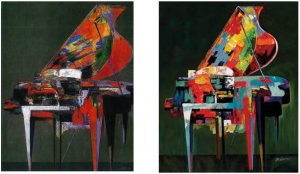Is this copyright infringement?
 The painting on the left is by a Chinese-born artist named Zheng Li. It’s called “Piano No. 9″. Li is not exactly an art-world fixture. For years, he lived in the U.S. and ran an art gallery in Roswell, GA. He has sold art to private individuals and corporations. But as far as we can tell, he hasn’t broken through to broader public notice.
The painting on the left is by a Chinese-born artist named Zheng Li. It’s called “Piano No. 9″. Li is not exactly an art-world fixture. For years, he lived in the U.S. and ran an art gallery in Roswell, GA. He has sold art to private individuals and corporations. But as far as we can tell, he hasn’t broken through to broader public notice.
That may change now. The painting on the right, titled “Piano Coloratura” and signed by someone named “P. Robert”, has been on sale in major outlets such as Kohl’s, J.C. Penney, and Z Gallerie. Li has sued all of these retailers, plus over 20 more who have sold “Piano Coloratura”, claiming that they are infringing his copyright in “Piano No. 9″.
Does Li have a case? Well, the paintings are certainly very similar, and that alone may get Li quite far with a jury. But if we look closer, it’s actually a really close case, and the correct outcome is difficult to call. Why?
Given how similar the paintings are it’s hard to believe that Li’s painting wasn’t copied. But if you break the paintings down, you’ll find that a lot of the copying at issue here isn’t actually illegal. For example, both paintings show a baby grand piano. But Li cannot own copyright in all pictures of baby grand pianos. And indeed, the baby grand in “Piano Coloratura” looks a bit different from Li’s piano. It’s shaped just a bit differently — and these small differences matter because all baby grand pianos look much alike, at least in their overall shape. Similarly, the “Piano Coloratura” piano is rendered at a similar angle to Li’s piano, but again, Li doesn’t have copyright in rendering pianos from the side. The pianos are also painted in a similar style using patches of bright color. But again, the execution of the style is not the same — the borders between colors are less distinct in Li’s painting — and, more broadly, copyright should not give any one artist ownership of a particular style of painting. Does impressionism belong to the first impressionist? Cubism to the first cubist? The same goes for colors. Copyright doesn’t allow anyone to own a color (trademark does, in a more limited sense that is not relevant here . . .).
So, is there a copyright claim? Yes. Li has a copyright claim in his original selection and arrangement of these otherwise uncopyrightable elements of subject matter, style, and color. In other words, Li has a copyright in the particular sum of the uncopyrightable parts.
The real question is how broad, or “thick”, a “selection and arrangement” copyright like this should be. Clearly, Li should have a copyright claim against anyone who reproduces his painting exactly — if the selection and arrangement copyright means anything, it must prohibit precise replication of Li’s painting, as would happen if someone simply pirated it and printed up a thousand copies. But how far should Li’s “selection and arrangement” copyright go in prohibiting mere “look-alike” paintings? That’s a very deep question, and one which is unsettled in the copyright law.
“Piano Coloratura” is not an exact copy. But it is pretty damn close. This is a borderline case. We’ll be watching.



